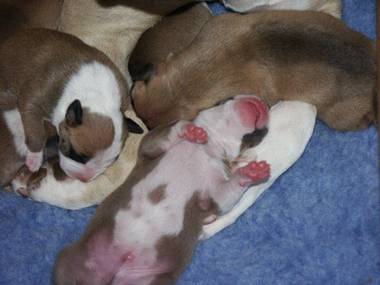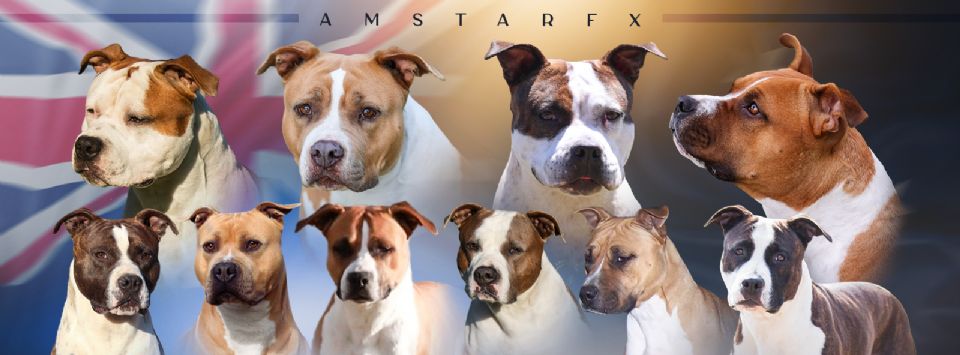Amstaff Info Page

BUYER BEWARE - Do not buy and American Staffordshire Terrier without Pedigree Papers...
Please be aware that any amstaff purchased with NO papers from any breeder, is automatically seen as a "pit bull type" in the eyes of the law, and in some states these dogs can be legally taken from you by the authorities and Put To Sleep. After obtaining this information many Amstaff breeders have joined together and aim to expose these kennels for what they are...Puppy farmers with no regard for the lives they bring into this world.
Do not put your pup at risk when all it costs the breeder to register a puppy on limited papers with the ANKC varies between $25 - $40 per pup, depending on the state. Please ensure that your puppy is registered with the controlling body of your state.
Click on my links page for further details and contact numbers of all controlling bodies within Australia through the ANKC website...
The American Staffordshire Terriers Arrival In Australia
The American Staffordshire Terrier was officially recognised in Australia on 1st January 1987.
The first Amstaff was imported from Hawaii in November 1986 by Mr & Mrs Murdoch of Red Cliffs Victoria. They were to become the first breeders/exhibitors of the breed, their kennel prefix being "Amstaff". The basis of their future breeding programme was to start with this import, "Rockislands O’Omua O Hawaii".
Bob & Ruths next import was the lovely brindle dog Ka Hanahou’s Lei O Makana. He was to become the first Australian Champion, and with the earlier imported bitch was to produce the first Australian bred litter.
In 1989, in Queensland, Dr Glucina of the "Araganu" prefix began to import Amstaffs into Australia. Over a period of time he imported the American Champion dog "Steeltowns Diamond Boy", another dog "Ka Hanahou’s Seamist", a bitch "Cock N Bulls Poppycock" and another bitch Haw N Blue Knight Mist. All having cropped ears, so unfortunately were unable to be shown in Australia.
From these imports Dr Glucina was to start his breeding programme and produced his first litter in 1990.
The Murdochs next import was another male "Ka Hanahou’s Rojo’s Sam", a red dog. He was 8 ½ months old when released from quarantine on February 14th 1991.
In October 1990 Mark & Wendy Evans, of Evastaff Kennels in Tasmania, were to purchase a brindle bitch from Hawaii. This was "Kalokos Lea", just 13 months old at time of purchase. She arrived in quarantine December 1990 and was released 12th April 1991. This bitch started her show career in August the same year and went through to her Australian title.
Kalokos Lea was the first bitch to produce a litter with both parents being Australian Champions.
Evastaff imported their second Amstaff in December 1992, released from quarantine May 1993. This was the striking black brindle dog "Hot Lava Indian at Evastaff". Jasper, as he is known to his friends, was to quickly gain his Australian title also.
In the following years imported semen produced some worthy Amstaff litters.
Lee Jenkins, of Bluesteel Kennel in Victoria, imported semen from two dogs. International Ch Willynwood Redneck and American Ch Rowdytowns Hardrock Café.
In Queensland Greg Gordon imported frozen semen from Am Ch Pacific Distant Thunder. And later, in partnership with Lynda Craw (Lyntiki), the lovely blue dog "Am Ch Pacific Hot Pursuit", who was co-owned by Greg and Lynda.
Lynda Craw also imported two Amstaffs from New Zealand in 1998, (originally imported from Hawaii into NZ). The dog, "Aust/NZ Ch Kupa’a Tama of Triskara" and the bitch "Triskara Mea Kau Ake (AI USA)". The bitch arrived in whelp.
Other breeders are investigating importing worthy dogs and bitches as well as further importation of frozen semen from good American bred dogs.
Interest in the Amstaff within Australia is steadily on the increase. This versatile breed can be utilised as a family companion, a show dog and as an obedience dog. The breed is continually creating interest in and out of the show ring, and this, combined with a responsible breeding programme will enure a steady development of the America Staffordshire Terrier in Australia.
American Staffordshire Terrier History
To correctly give the origin and history of the American Staffordshire Terrier, it is necessary to comment briefly on two other dogs, namely the Bulldog and the terrier.
Until the early part of the 19th century; the Bulldog was bred with great care in England for the purpose of baiting bulls. The Bulldog of that day was vastly different from our present-day "sourmug." Pictures from as late as 1870 represent the Bulldog as agile and as standing straight on his legs-his front legs in particular. In some cases he was even possessed of a muzzle, and long rat tails were not uncommon. The Bulldog of that day, with the exception of the head, looked more like the present-day American Staffordshire Terrier than like the present-day Bulldog.
Some writers contend it was the white English Terrier, or the Black-and-Tan Terrier, that was used as a cross with the Bulldog to perfect the Staffordshire Terrier. It seems easier to believe that any game terrier, such as the Fox Terrier of the early 1800s, was used in this cross, since some of the foremost authorities on dogs of that time state that the Black-and-Tan and the white English Terrier were none too game, but these same authorities go on to stress the gameness of the Fox Terrier. It is reasonable to believe that breeders who were attempting to perfect a dog that would combine the spirit and agility of the terrier with the courage and tenacity of the Bulldog, would not use a terrier that was not game. In analyzing the three above-mentioned terriers at that time, we find that there was not a great deal of difference in body conformation, the greatest differences being in color, aggressiveness, and spirit.
In any event, it was the cross between the Bulldog and the terrier that resulted in the Staffordshire Terrier, which was originally called the Bull-and-Terrier Dog, Half and Half, and at times Pit Dog or Pit Bull Terrier. Later, it assumed the name in England of Staffordshire Bull Terrier.
These dogs began to find their way into America as early as 1870, where they became known as Pit Dog, Pit Bull Terrier, later American Bull Terrier, and still later as Yankee Terrier.
In 1936, they were accepted for registration in the AKC Stud Book as Staffordshire Terriers. The name of the breed was revised effective January 1, 1972 to American Staffordshire Terrier. Breeders in this country had developed a type which is heavier in weight than the Staffordshire Bull Terrier of England and the name change was to distinguish them as separate breeds.
The American Staffordshire Terrier's standard allows a variance in weight, but it should be in proportion to size. The dog's chief requisites should be strength unusual for his size, soundness, balance, a strong powerful head, a well-muscled body, and courage that is proverbial.
To clarify the confusion that may exist, even in the minds of dog fanciers, as to the difference between the American Staffordshire Terrier and the Bull Terrier, a comment on the latter may be helpful. The Bull Terrier was introduced by James Hinks of Birmingham, who had been experimenting for several years with the old bull-and-terrier dog, now known as Staffordshire. It is generally conceded that he used the Staffordshire, crossed with the white English Terrier, and some writers contend that a dash of Pointer and Dalmatian blood was also used to help perfect the all-white Bull Terrier.
In mentioning the gameness of the Staffordshire, it is not the intention to tag him as a fighting machine, or to praise this characteristic. These points are discussed because they are necessary in giving the correct origin and history of the breed. The good qualities of the dogs are many, and it would be difficult for anyone to overstress them.
The American Staffordshire Terrier Standard
(American Kennel Club)
Breed History
The American Staffordshire Terrier is not a new breed. Although it gained American Kennel Club registration and recognition in 1936, it has been developed since the early 1800's as a result of crosses between the bulldogs of that time and game terriers. One of the early and very famous AKC registered Staffs was Pete the Pup, (real name Lucenay's Peter), dog star of the original Our Gang comedies of the 1930's.
Although the early ancestors of this breed came from England, the development of the American Staffordshire Terrier is the story of a truly American breed. This type of dog was instrumental in the success of farmers and settlers who developed this country. They were used for general farm work, hunting wild pigs, bears, and other large game, guarding the homestead, and general companionship.
A number of the early ancestors were also developed for the "sport" of dog fighting. The extraordinary vitality of this breed is a direct result of breeding for successful fighting dogs. This now illegal activity is, unfortunately, more often cited as the early purpose of the dogs rather than the general farm work.
Although ancestors of the American Staffordshire were fighting dogs, the selective breeding since the 1930's has been away from the fighting heritage. The American Staffordshire Terrier of today is a companion and show dog, rather than a gladiator. Although more rarely used on the farm now, the talents that made him a good all purpose dog are still to be found in the breed.
